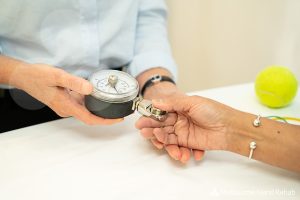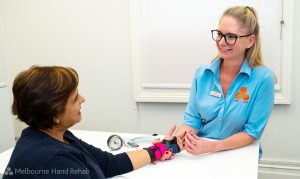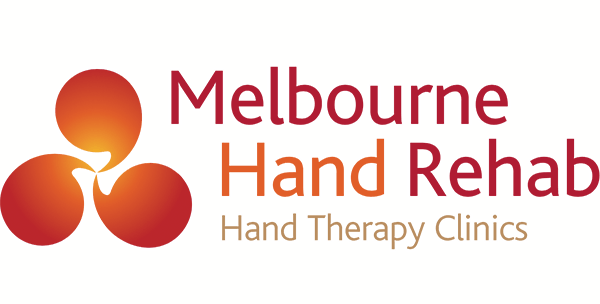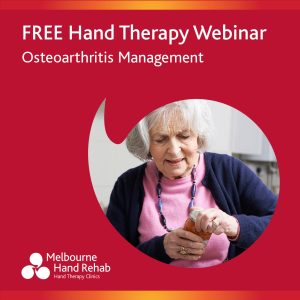
17 May Hand pain from arthritis? This may help
Occupational therapy eases pain and improves function when osteoarthritis occurs in the joint connecting thumb and wrist.
Hand therapy is an area of advanced practice for occupational therapists and physiotherapists with expertise in assessing, diagnosing and treating upper limb injuries – fingers, hand, wrist, elbow and shoulder. To find out more about how our hand therapists may assist in the assessment and treatment of your OA, see > Arthritis in Hands & Wrist.
The following is a repost from an article published by Harvard Health Publishing by Robert H. Shmerling MD on August 11 2022. You can see the original article > here
When it comes to arthritis, some joints seem to get all the attention. We talk about knees and hips an awful lot. Our knees and hips must work well for walking, and a third or more of adults over age 65 develop osteoarthritis in these joints, resulting in over a million joint replacements in the US each year.
But what about the first carpometacarpal joint that connects your thumb to your wrist? That’s surprisingly important, yet most people can’t name it and only become aware of it once it becomes arthritic. Fortunately, research recently confirmed that a common therapy requiring no medication can effectively treat this type of arthritis.
The amazing opposable thumb
Known more simply as the first CMC joint, it allows us to move our thumb through a wide range of motion. If you appreciate the many uses of opposable thumbs, you can thank the first CMC joint! Having opposable thumbs allows us to grasp objects, open jars, turn doorknobs, write, make a tight fist, turn a key, and perform countless other everyday activities.
That’s why the first CMC joint may be the most underappreciated joint in the body.

How do you know if you have first-CMC arthritis?
Common symptoms include:
- aching at the junction of your thumb and wrist
- pain that worsens with use, such as using keys, writing, or opening a jar
- poor ability to function, including weakness of grip
- a bony prominence over the joint, often due to extra bone growth
- pain at rest and/or at night if the arthritis is severe.
Your doctor may suspect osteoarthritis of the first CMC based on your symptoms and physical examination, but an x-ray can confirm the diagnosis.

Melbourne Hand Rehab hand therapist tests a patients thumb strength using a grip gauge.
What treatments can help?
Treatment options for osteoarthritis of any joint, including the first CMC, are limited. And they don’t always work well. In the most recent US guidelines for hand or thumb osteoarthritis, only the following are strongly recommended:
- wearing a brace or splint (called an orthosis)
- exercises designed for this joint
- educational programs that encourage people to manage bothersome symptoms
- anti-inflammatory drugs, such as ibuprofen.
A brace, exercise, and education are typically provided through occupational therapy, a form of physical therapy focused on hand and wrist functions essential to activities of daily life, such as bathing or getting dressed. Yet, the impact of occupational therapy had not been comprehensively evaluated.

A new study confirms effectiveness of occupational therapy
The study enrolled 180 people with first-CMC osteoarthritis. Their average age was 63 and 80% were women.
Half were randomly assigned to receive occupational therapy (including education, exercises, braces, and assistive devices) while the other half only received information about osteoarthritis.
The results demonstrated that a three-month course of occupational therapy effectively relieved pain at rest and after exercise, and improved grip strength and function.
This study is among the best research evaluating occupational therapy for this condition. However, it had some limitations. Treatment assignments were not blinded: participants knew if they received occupational therapy or not, so expectations and the impact of the placebo effect could have affected the results. The study lasted just three months, so the impact of occupational therapy over the long term was not assessed.
What other questions about first-CMC osteoarthritis should be answered?
Despite how common this form of osteoarthritis is and how much trouble it causes, many questions remain. It would be helpful to know:
- Why does osteoarthritis develop in the joints of the hand in the first place?
- How can osteoarthritis be slowed, stopped, or reversed?
- How long does the improvement provided by occupational therapy last in people who have osteoarthritis of the first CMC?
- If symptoms improve after an initial course of occupational therapy and come back later, will repeat treatments work as well?
- Does occupational therapy work as well for men with this type of arthritis as it does for women?
- Does it work as well for severe arthritis as for milder cases?
- What elements of occupational therapy are most important, and are they widely accessible? For example, is bracing more important than exercise, and are certain braces or exercises better than others? Are experienced occupational therapists readily available for most people with this condition?

The bottom line
If you live long enough, chances are good that you’ll develop osteoarthritis of the joint that helps make the amazing opposable thumb work smoothly. Hopefully, we’ll have better treatments before that happens. Though it’s reassuring that occupational therapy can help, the holy grail for anyone who might develop osteoarthritis is a treatment to prevent it, stop it from getting worse, or even reverse its damage. Fortunately, there are researchers hard at work to discover such treatments.
Robert H. Shmerling, MD
Senior Faculty Editor, Harvard Health Publishing; Editorial Advisory Board Member, Harvard Health Publishing
If you are experiencing finger, hand or wrist pain, don’t hesitate to get in touch. We’d love to help you.
BOOK AN APPOINTMENT
For more information, call us directly on 03 9458 5166
For more information
- Blog: Can hand therapy really help my osteoarthritis?
- Blog: What can I do about osteoarthritis in my thumb?
- FREE Hand Therapy Webinars – osteoarthritis
- Arthritis Australia
- What is hand therapy?
- Custom made leather splints
FREE Hand Therapy Webinar: Information designed to provide a better understanding of osteoarthritis and an overview of the most up-to-date hand therapy options for treating and managing the condition. Learn how hand therapy can help manage your arthritis and reduce pain symptoms. An introduction to massaging techniques, splint options and exercises. > Find out more



